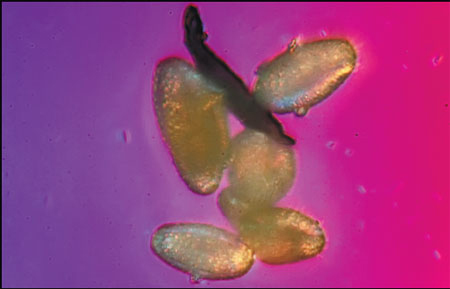
A picture of smog particles under the microscope taken by Zhang Chao
|
It has been two years since China Daily last interviewed 31-year-old Zhang Chao. The Beijing-based micrograph enthusiast still wears the same hair style, even the same coat. But one thing is very different: He's become a celebrity in cyberspace almost overnight, after his pictures, which depict what the rampant smog in Beijing looks like under his microscope, spread like a virus on China's major micro-blogging site Sina Weibo, since he posted them last Friday. Now the media is hounding him for interviews. "Why do I become famous when I took pictures of the smog?" he asks with a wry smile. "I have taken numerous pictures of beautiful nature whenever I have spare time, but there are no more than 10 interview requests for me every year before. Now, I have to answer dozens of phone calls from media every day. "But I only gained 2,000 more followers over the weekend. I guess the micro blog is not as popular as before," he says, jokingly. On Monday morning, a camera crew from a TV station based in southern Hunan province even took a flight to Beijing just to record how Zhang takes pictures of the Beijing's most-talked about feature: the floating enemies in the air. The process is not complicated: He puts microscope slides on his windowsill and collects the samples covered by fallen dust after 10 hours. Zhang's apartment is on the eighth floor, which he says is perfect for capturing the densest levels of smog. As a Beijing native, Zhang explains his original purpose is to "deconstruct" Beijing's smog and unveil its shroud of mystery. "People have higher and higher standards for the environment," he says. "When I was a child, I was annoyed by the frequent sandstorms, so I feel Beijing's air seems much better now all in all because there are hardly any sandstorms in recent years. Now, we've noticed PM2.5, which has long been neglected." Although he graduated as a science major from Beijing Normal University, Zhang says it is difficult for him to give an exact definition of what smog is in Beijing. "It's too complicated, and its ingredients keep changing." Under his scope, which magnifies the sample 1,000 times, the smog is found to contain minerals, fragments of animal fur and insects, seeds and burnt dust. But many are compounds, he says, which are more difficult to identify. "I wanted to know if there are many pollen grains in the early spring's smog, and my guess turns out to be right," Zhang says, noting there are on average 10 pollen grains found on each slide. "Though the number is low compared with other ingredients of smog, it may partially explain why smog makes us feel uncomfortable because many people are allergic to pollen." Zhang realizes that he may have disappointed the public because he can't show the inner construction of PM2.5, today's most notorious element in smog. It is beyond the capacity of his microscope and camera to explore such tiny grains. Working as a freelancer and editor for an astronomy magazine affiliated with the National Astronomical Observatories of the Chinese Academy of Sciences, his regular job is to stare at the starry firmament and write popular-science articles. However, he is proud to have stirred equal interest by observing the micro world. "You cannot imagine how splendid the micro world is until you fall in love picturing bugs in the garden, different kinds of sand grains, or some tiny corners in our daily lives. "My favorite is to shoot snowflakes. I would love to compile my snowflake pictures to publish a book. But you know how much warmer Beijing was in the past winter - I should have traveled to northeastern China to get more pictures." By Wang Kaihao (China Daily) |
中国日报两年之前曾经采访过31岁的摄影师张超。如今,这个北京显微摄影的狂热爱好者依然留着同样的发型,甚至穿着同样的衣服。 但有一件事和以前有了很大的不同。自从他在3月25日把拍摄到的显微镜下的北京雾霾照片发到网上后,这些照片就在新浪微博上疯传。他也在一夜之间成为了网络名人。现在,许多媒体在追着他进行访问。 “为什么我拍了雾霾照片就变得有名了?”他笑着问道。“之前我一有空闲时间就去拍摄美丽的自然风景,已经拍了许多张照片,但每年接到的采访不足10次。现在,我每天都得回复数十次媒体的电话。” “不过整个周末,我的粉丝只增加了2000多人,看来微博不如之前流行了。”他开玩笑地说。 在4月1日,湖南省南部的一家电视台甚至派了一位摄影师,专程飞到北京拍摄他如何对这些漂浮在空气中的健康敌人,北京常被提及的特征——雾霾进行拍照。 整个过程并不复杂。他把显微镜载片放在他的窗台上,收集10个小时后的落灰样品。 张超的房子在8层,他认为在这个位置可以很好地收集到最严重的雾霾样品。 作为一个北京人,张超说他的初衷是“解构”雾霾并揭开雾霾的神秘面纱。 张超说:“人们对环境标准的要求越来越高了。在我小的时候,最烦的是经常出现的沙尘暴。现在北京的空气质量看起来好了很多,因为沙尘暴在近几年很少出现了。如今,我们又开始关注被长期忽略的PM2.5。” 虽然张超毕业于北京师范大学科学类专业,但他也很难解释清楚北京雾霾到底包含什么成分。他说:“雾霾成分太复杂了,而且一直处于变化之中。” 在他的显微镜下,雾霾颗粒样本放大了1000倍,可以看到雾霾中包含了矿物质、动物皮毛和昆虫的碎片、种子和燃烧后的粉尘等物质。但张超指出,还有很多是复合物,很难辨别是什么物质。 张超说:“我想知道在早春的雾霾中是不是有花粉颗粒,我的猜测应验了。平均每个载片上有10个花粉颗粒。” “虽然与雾霾中的其他成分相比,花粉所占比例较低,但这也部分地解释了为什么雾霾让我们感觉不舒服,因为很多人对花粉过敏。” 张超意识到他可能会让公众失望,因为他没能展示出PM2.5的内部结构。PM2.5才是雾霾成分中最臭名昭著的。但由于PM2.5颗粒过小,他的显微镜和相机无法显示和拍照。 张超是自由职业者和《中国国家天文》杂志编辑。这家杂志由中国科学院国家天文台主办。他的日常工作就是盯着天空,然后写一些科普文章。不过,他对微观世界也有着同样的兴趣。 “你无法想象微观世界是多么精彩,除非你爱上拍摄花园里的虫子、不同类型的沙子和一些我们日常生活的角落。” “我最喜欢给雪花拍照。我希望将我拍摄的雪花照片出版一本书。但你也知道去年北京多么暖和,我本应到中国的东北多拍一些照片。” (记者王恺昊 译者 ewhyou 编辑 丹妮) |